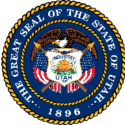Utah had a hard time becoming a state. Utah became part of the United States in 1848. They had previously been part of Mexico. The Treaty of Guadalupe Hidalgo after the Mexican-American War gave the United States Utah, among other western lands.
The leaders of Utah’s Mormon pioneers immediately began to work for statehood. They held a Constitutional Convention and proposed borders for a new state to be called “Deseret.” It would have included not only today’s state of Utah, but also most of Nevada and Arizona, and parts of southern California, Wyoming, Colorado, New Mexico, Oregon, and Idaho. (They needed a really big state in order to meet the requirements for population size.) They elected all Mormon leaders, including Brigham Young as governor and a state representative. They sent that representative to Washington and he asked to be seated in Congress. Congress said no.
For one thing, the state of Deseret would have been enormous. Congress didn’t want a state that big and potentially powerful in the future. They also wanted more diversity in the government in Utah. What’s more, slavery was a contentious question in the United States at that time. Congress tried to keep a balance between slave states and free states so neither side would become too powerful. A state the size of Deseret would certainly upset that balance.
Instead of accepting Utah as a state, Congress set out two new territories: Utah and New Mexico. They would both be allowed to vote on whether to allow slavery in their territories or not. This was part of the Compromise of 1850. The federal government accepted Brigham Young as governor, but appointed both Mormons and non-Mormons to the other political positions in the Utah Territory. Utah kept working toward statehood.
Then things got complicated.
Polygamy
In 1852, word got out that some Mormons practiced polygamy: having multiple wives. There was no social media in those days, but word traveled as fast as it could given the available technology. Soon people across the nation were speaking out against statehood for Utah. The first Republican party platform talked about “twin relics of barbarism: polygamy and slavery.”
Utah kept holding constitutional conventions and asking for statehood. Congress kept saying no. Meanwhile, the controversy over polygamy kept making headlines. Polygamy was outlawed in all U.S. territories. The argument went to the Supreme Court, which upheld that law. Congress made a law which disenfranchised — took the vote away from — polygamists. A number of polygamists were arrested. Congress took the vote away from Utah women.
Utah still wanted statehood, but was still unwilling to change their law.
President Grant said, “In nearly every annual message … I have called attention to the … scandalous condition of affairs existing in the Territory of Utah, and have asked for definite legislation to correct it.”
President Rutherford B. Hayes said, “Polygamy is condemned as a crime by the laws of all civilized communities throughout the world.”
As the railroad began bringing more new people into Utah, Mormons stopped being the majority in their territory. The controversy heated up. In 1887, a new constitution made polygamy illegal in Utah Territory… but a misdemeanor. Congress said no once again. Polygamy was a real obstacle to statehood.
In 1890, the president of the LDS (Mormon) church announced that he would “submit to those laws” and advised all Mormons to do so. In 1893, President Benjamin Harrison proclaimed amnesty for polygamists. In 1894, Congress passed an enabling act for Utah which said that they could become a state, but only if they made polygamy illegal.
Statehood
In 1895, Utah produced a constitution outlawing polygamy, and in 1896 Utah became a state at last.
For 50 years, Utah worked to become a state. They formally requested statehood over and over. One of the main reasons Utah wanted statehood was to have greater self-determination. “There’s a big difference between being a state and being a territory,” a Utah government history website claims. “A territory is kind of like a colony. As you remember, the early American colonists didn’t like being a colony of Britain! Neither did Utahns like being a territory of the United States.”
It was clear from the actions of the federal government in Utah’s territorial days that the federal government has complete power over a territory. Although the “commonwealth” party continues to peddle a fantasy in which Puerto Rico has some kind of special non-territorial relationship with the U.S. federal government, Puerto Rico’s relationship with the U.S. government shows that this is not going to happen.
Congress has said repeatedly that Puerto Rico is a territory like other territories and will never have a special relationship with the U.S. outside of statehood. The Supreme Court and other courts have said over and over (most recently in July, 2018) that Puerto Rico is a territory and completely under the power of Congress.
Just so, Utah tried for 50 years to create a special kind of statehood. They wanted to be able to have laws that contradicted the laws of the United States, and still to be a state. It didn’t happen. When they gave up that fantasy, they were able to achieve their goal of statehood.
Puerto Rico’s challenges in gaining statehood are less severe than the challenges Utah faced. Tell your congressional reps that you favor statehood for Puerto Rico.








One response
I support statehood for Puerto Rico